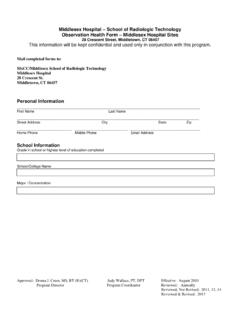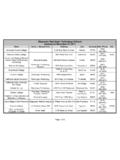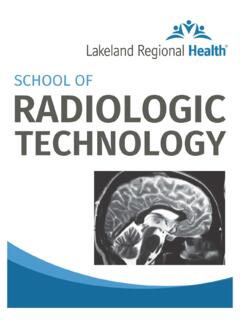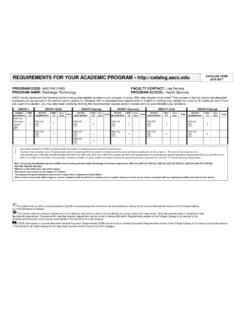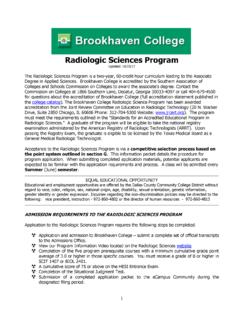Transcription of School of Radiologic Technology - City of New York
1 School of Radiologic Technology General Information Summary General Information Summary Mission Statement, Goals & Student 1-2. Learning Outcomes General Information 2-5. School Calendar 6. Admissions Information 7-10. Finances 11-12. Curriculum and Course Description 13 -17. Grading Policy 17. Graduation Requirements 18. Credentials 19. MISSION STATEMENT. T he mission of Bellevue Hospital Center School of Radiologic Technology is to promote, educate and train students in the medical imaging profession. Through an effective teaching and learning environment, graduates of the School will be able to support other health care professionals, serve the health care community, and provide quality patient care.
2 The program's mission will be achieved through the following five goals and associated student learning outcomes. Goals: 1. The program will graduate competent entry-level radiographers. Student Learning Outcomes: o Students will be able to perform entry-level positioning skills. o Students will demonstrate safe radiation protection procedures. o Students will demonstrate patient care assessment and vital sign competency. 2. The program will provide an education that promotes effective communication skills. Student Learning Outcomes: o Students will demonstrate effective writing and speaking skills with peers.
3 O Students will demonstrate effective communication skills with patients and other health care professionals. o Students will demonstrate data entry and acquisition skills. o Students will demonstrate effective non-verbal communication. 3. The program will provide an education that promotes effective problem solving and critical thinking skills. Student Learning Outcomes: o Students critique their radiographs and others (via PACs) and identify the requirements of a diagnostically acceptable radiograph and list solutions for images that are suboptimal. o Students will correctly make changes to exposure factors to compensate for various body parts, sizes, and pathologies.
4 O Students will perform non-routine radiographic procedures on a variety of patients. 4. Graduates will demonstrate responsible behavior and professional development. Student Learning Outcomes: o Students will demonstrate responsible behavior and understand the importance of professional and ethical policies. o Students will understand the value of life-long learning, professional membership, and interview preparation. o Students will have voluntarily joined national and/or state professional (societal) organizations. o Graduates will demonstrate professional growth after graduation. 5.
5 The program will graduate a sufficient number of certified entry- level radiographers to meet the needs of the health care community. Student Learning Outcomes: o Students will complete the program. o Students will pass the credentialing exam. o Students seeking employment in the field will find jobs after graduating. o Graduates will indicate that they were adequately prepared as entry- level radiographers. o Employers will indicate that graduates are adequately prepared as entry-level radiographers. GENERAL INFORMATION. A. Introduction. Founded in 1972, the Bellevue Hospital Center School of Radiologic Technology (BHCSRT) offers a 24-month (six trimesters) certificate program in Radiologic Technology .
6 The program does not grant a degree. All academic, laboratory, and clinical instruction is held on the Bellevue Hospital Center campus. Graduates are eligible to apply for the American Registry of Radiologic Technologists (ARRT). Certification and NYS Licensure. The program involves approximately 950 contact hours of classroom work, 1,770. hours of clinical training, and 288 hours of workshops and independent study. School hours are from 8:30 am to 4:30 pm, Monday through Friday. All courses are required and must be taken sequentially. Successful completion of all academic courses and required clinical competencies is required for graduation.
7 B. Employment, Salary, and Continuing Education Requirements. The most recent New York State Department of Labor statistics indicate a Radiologic technologist entering the field earns a mean (average) annual salary of $49,760 and an experienced worker a mean (average) salary of $74,930. For additional information on a career in radiography go to: , , or For a list of other radiography programs in New York State go to: or According to New York State, if the tuition, fees, and costs exceed 200% of the mean annual salary they are considered to be excessive. The total tuition, fees, and other costs of BHCSRT.
8 Are approximately 35% of the entry-level mean annual salary. While the School does not provide or guarantee job placement, classes are conducted in resume writing, job search, and interview preparation. Radiographers are employed in hospitals, imaging centers, urgent care centers, doctors' offices, HMO's and the military. Once a graduate is certified by the ARRT, he/she is eligible to apply for New York State licensure and is also eligible to be employed in most states. ARRT. certification is time-limited to 10 years. Continuing education (CE) is required for both renewal of the ARRT Registration and NYS License.
9 C. Accreditation The School is accredited by the Joint Review Committee on Education in Radiologic Technology (JRCERT). Graduates of the program are eligible to apply for the American Registry of Radiologic Technologist (ARRT) certification exam and New York State Department of Health licensure. Accreditation-The Joint Review Committee on Education in Radiologic Technology (JRCERT). 20 North Wacker Drive, Suite 2850. Chicago, IL 60606-3182. Tel. (312) 704-5300. Web Site: D. Sponsorship/Faculty. The School is sponsored by Bellevue Hospital Center (BHC) which is part of the New York City Health and Hospitals Corporation (HHC).
10 The New York City Health and Hospitals Corporation is the largest municipal hospital and health care system in the country providing medical, mental health and substance abuse services through its 11. acute care hospitals, 4 skilled nursing facilities, 6 large diagnostic and treatment centers and more than 80 community based clinics. HHC Health and Home Care also provides health services at home for New York residents. BHC is considered the flagship hospital and is accredited by The Joint Commission (TJC). Bellevue Hospital Center serves the health care needs of a diverse community and provides an opportunity for each student to develop empathic and culturally sensitive patient care skills.










